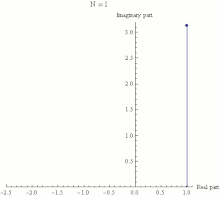
In mathematics, Euler's identity (also known as Euler's equation) is the equality
e
i
π
+
1
=
0
{\displaystyle e^{i\pi }+1=0}
where
e is Euler's number, the base of natural logarithms,
i is the imaginary unit, which satisfies i2 = −1, and
π is pi, the ratio of the circumference of a circle to its diameter.
Euler's identity is named after the Swiss mathematician Leonhard Euler. It is considered to be an example of mathematical beauty.
== Explanation ==
Euler...